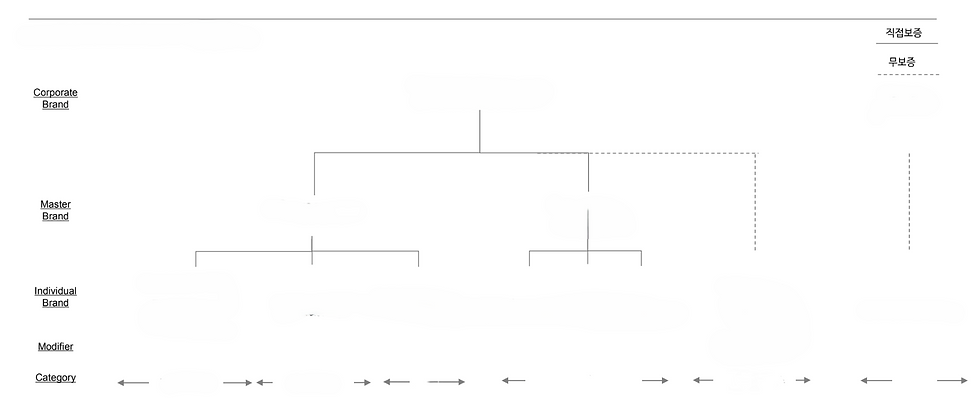브랜드 포트폴리오 전략의 접근 (Brand Portfolio Strategy Approach)
- Josh & Liuyang

- 4월 11일
- 7분 분량
최종 수정일: 4월 28일
'포트폴리오 전략은 브랜드에게 맞는 역할의 공간을 만들어주는 것'
브랜드 포트폴리오, 익숙하지만 누군가에는 여전히 생소한 전략
브랜드 포트폴리오라는 처음 들어보면 어렵다고 생각할 수 있고, 무엇인가 접근이 쉽지 않은 것처럼 보인다. 실무진들도 막상 브랜드 포트폴리오를 접목하려고 하면 어디서부터 시작해야 할지 가장 막연하다. 브랜드 아이덴티티 수립보다 더 복잡해 보이기도 하다. 하지만 기본적인 개념과 진행 방법만 이해한다면 내부에서도 쉽게 결정할 수 있는 것이 포트폴리오 전략이다. 보수적이고 수직적인 의사체계에서는 전문성이 부족할 경우 내부 신뢰의 문제로 결정이 어려울 수 있으나, 리더 간 소통이 자유로운 수평적이고 상호 간 신뢰가 높은 곳에서는 자체적으로 진행이 충분히 가능하다고 본다. 앞서 브랜드 아이덴티티 체계 전략이 내부 멤버 간 동질화를 위해 자체적으로 진행하는 것이 필요했다. 반면 브랜드 포트폴리오 전략은 내부 자원과 상황을 누구보다 잘 알기 때문에 내부에서 진행하는 것이 적합하다. 상품기획, 제품 전략과 매우 맞닿아 있어서 주기적으로 향후 제품의 확장, 축소 등을 관리하며 업데이트가 필요하다. 그렇다 보니 포트폴리오 전략의 접근방법을 이해하고 사업전략과 맞물려서 브랜드 전략을 꾸려나가는 것이 매우 필요하다.
실무에서 브랜드 포트폴리오 전략이 필요한 경우
브랜드 포트폴리오는 아래와 같은 조건이 있을 때 고려해 볼 수 있다.
1) 시장 세분화에 대응이 필요한 경우 (가격, 연령, 라이프스타일 등에 맞는 상품, 제품 제공이 필요한 경우)
2) 제품의 수가 많고 복잡하여 내부 자원분배 등 전략방향성의 옳고 그름 등 판단이 필요한 경우
3) M&A 이후 인수한 브랜드와 기존 브랜드 간의 통합 전략이 필요할 경우
4) 브랜드 확장 시 브랜드 자산의 효과적인 배분 결정이 필요한 경우
5) 경쟁사와의 시장경쟁에 있어서 적절한 브랜드 대응이 필요한 경우 등
그렇다고 단일 브랜드에서는 적용이 불가능한 전략인가라고 하면 꼭 그렇지는 않다.
일반적으로 식품, 생활용품, 전제제품과 같은 소비재 등 다양한 제품들이 많을 때 고려한다. 단일브랜드만 있다고 해서 전혀 사용하지 않는 것은 아니다. 단일브랜드를 갖고 있다고 하더라도 브랜드 확장이나 신규브랜드를 개발할 때 브랜드 레버리지에 대한 가능성을 보고 접근해야 하기 때문에 필요하다.
브랜드 포트폴리오 전략 결과물의 차이
브랜드 포트폴리오 전략은 결과물에 대해서 생각하는 차가 가장 큰 전략이기도 하다. 지금의 시장환경을 살펴보면 포트폴리오 전략이 꼭 필요한가 라는 생각이 들 때가 있다. 어쩌면 당신 기업내부에서 이미 수행하고 있는 것들이 포트폴리오 전략에서 취하는 전술에 따라 이미 진행되고 있었을 가능성도 매우 크다. 그럼에도 만약 외부 용역에 맡긴다면 내부에서 할 여력이 없거나 내부 설득이 필요해서 과업을 진행하는 경우가 대부분일 것이다. 내부적 컨센서스만 있다면 브랜드 방향성보다 더 쉽게 결정할 수 있다고 생각한다.
브랜드 포트폴리오하면, 참고할 수 있는 서적도 그리 많지 않다. 일반적으로 2004년 데이비드 아커가 지은 브랜드 '포트폴리오 전략서'를 많이 참고한다. 또 켈러가 지은 브랜드 매니지먼트에도 포트폴리오 전략에 대해 잘 나와있다. 하지만 브랜드 경험과 지식이 어느 정도 쌓여 있지 않으면 처음부터 읽기는 쉽지 않다. 책 속의 사례 또한 해외 사례 위주로 있다 보니 잘 와닿지 않는 부분도 있다. 앞으로 브랜드 포트폴리오의 이론서를 실무에 적용할 때의 과정을 하나씩 설명하면서 어떻게 현장에 반영하고 활용하면 좋을지 생각을 나누도록 하겠다.
결론부터 말하면, 브랜드 포트폴리오 전략은 아래의 한장을 그리기 위함이다. 아래의 한 장을 그리기 위해 브랜드의 역할과 정의가 필요하며 브랜드 상하, 좌우간의 시너지, 그리고 브랜드의 자산을 어디까지 확장시키는지에 대한 운용 방향성이 결정된다.

석학들이 말하는 브랜드 포트폴리오 전략의 정의
브랜드 포트폴리오 전략하면, 흔히들 기업이 여러 브랜드를 효과적으로 관리하고, 시장에서 경쟁력을 강화하기 위한 중요한 전략이라고 말을 한다. 맞는 말이다. 그런데 효과적으로 관리한다던지, 경쟁력을 강화한다는 말이 추상적이고 머리에 잘 그려지지 않는다. 브랜드 석학들의 정의를 빌려오면,
1) 데이비드 아커는,
각 브랜드의 역할 정의와 중복 최소화
브랜드 간 시너지 창출
고객군과 시장 목표에 따라 포트폴리오 균형 유지
브랜드 투자 우선순위 설정
2) 케빈 켈러는,
브랜드 간 역할과 관계의 명확화
고객의 인지와 선택을 돕는 구조로 설계
확장 가능성, 리스크 분산, 시장 대응력 고려
결국 아커나 켈러가 말하는 공통점은,
브랜드 간 관계를 명확히 하여 고객 인식을 명확하게 만듦
브랜드마다 역할과 타깃이 다름을 이해하고 설계
포트폴리오는 미래 확장을 고려해야 함
브랜드 간 중복보다 상호 보완과 시너지 창출이 중요
브랜드 포트폴리오 전략의 목적은
위의 공통점들을 잘 연결하면 목적과 의미가 잘 부합된다. 브랜드들의 역할을 명확히 규정하고 각 브랜드의 인식을 확보한다. 그리고 브랜드 간 위 아래, 좌우의 시너지를 극대화한다. 즉 시장에서의 성공을 위해 기업내 브랜드 자산의 활용 범위를 결정하는 것이 포트폴리오 전략의 목적이자 의미다.
좀 더 쉬운 예로 말해보자. 당신 가정에 10명의 아이가 있다고 가정한다. 당신은 자수성가한 기업의 오너다. 무일푼에서 시작해서 회사에 인생을 바쳤으니 '당신의 인생 = 기업'이나 다름없다. 따라서 당신의 인생 목표는 '기업이 잘 성장하는 것이다. 당신의 자녀들도 회사에 보탬이 되는 아이들로 성장해서 당신 회사에 필요한 것들을 해주기 기대한다.' 아이들을 향후 어떻게 성장할지 목적을 정하고, 역할을 부여한다. 재벌가의 막장 드라마처럼 한 명은 정치인, 다른 한 명은 법 쪽으로, 다른 아이는 교수, 다른 아이는 의사, 다른 아이는 경영능력 등으로 회사가 성장하는데 필요한 능력들로 최종 골을 배분하는 것이다. 기업 내 각각의 역할과 위치를 만들어 궁극적으로는 회사가 잘 운영될 수 있도록 설계하고 계획하는 것이다.
다음 장부터는 브랜드 포트폴리오 전략을 실무에 적용하기 위해 어떤 내용들과 방법들이 있는지 알아보고 실제 적용할 때 어떤 점들을 고려하는지 하나씩 살펴보도록 하겠다.
“A portfolio strategy creates a space for a brand to play its role.”
Brand portfolio: familiar to some, but still unfamiliar to others
When you first hear the term “brand portfolio,” it may sound difficult and seem hard to approach. Even practitioners find it difficult to know where to start when trying to incorporate a brand portfolio. It may seem more complicated than establishing a brand identity. However, once the basic concepts and processes are understood, portfolio strategy can be easily decided internally. In conservative, vertical decision-making structures, lack of expertise may lead to trust issues and difficulty in decision-making. However, in horizontal, open communication environments with high mutual trust, it is entirely feasible to implement internally. Previously, brand identity system strategy required internal alignment and was therefore conducted internally. On the other hand, brand portfolio strategy is more suitable for internal implementation because those involved are most familiar with internal resources and circumstances. It is closely tied to product planning and product strategy, requiring regular updates to manage future expansions or reductions in product lines. As a result, understanding the approach to portfolio strategy and aligning it with business strategy is crucial for developing brand strategy.
When brand portfolio strategy is needed in practice
Brand portfolio should be considered when the following conditions are met.
1) When it is necessary to respond to market segmentation (when it is necessary to provide products that match price, age, lifestyle, etc.)
2) When there are many products and they are complex, and it is necessary to determine the correctness of strategic direction, such as internal resource allocation
3) When integration strategy is needed between acquired brands and existing brands after M&A
4) When effective allocation of brand assets is required during brand expansion
5) When appropriate brand responses are needed to compete with competitors, etc.
Does this mean that such strategies are impossible for single brands? Not necessarily.
Generally, this is considered when there are many diverse products such as consumer goods like food, household items, and finished products. Having a single brand does not mean that such strategies are completely unusable. Even with a single brand, it is necessary to consider the potential for brand leverage when expanding brands or developing new ones.
Differences in the results of brand portfolio strategies
Brand portfolio strategies differ most significantly in terms of their results. Looking at the current market environment, one may wonder whether a portfolio strategy is really necessary. It is highly likely that some of the tactics used in portfolio strategies are already being implemented within your company. Nevertheless, if you decide to outsource it, it is usually because there is no internal capacity or because internal consensus is needed to proceed with the task. If internal consensus is already in place, decisions can be made more easily than when determining brand direction.
There are not many books to reference when it comes to brand portfolio strategy. The most commonly referenced book is “Brand Portfolio Strategy” written by David Aaker in 2004. Keller's “Brand Management” also covers portfolio strategy well. However, it is not easy to read from the beginning without a certain level of brand experience and knowledge. Additionally, the cases in the book are mostly overseas examples, so some parts may not resonate well. In the future, I will explain the process of applying brand portfolio theory to practical situations step by step and share thoughts on how to reflect and utilize it in the field.
In conclusion, brand portfolio strategy is about drawing the following chart. To draw this chart, it is necessary to define the role of the brand, determine the synergy between brands above and below, and decide the direction of brand asset expansion.
Brand Portfolio System
Definitions of brand portfolio strategy by experts
When we talk about brand portfolio strategy, we often refer to it as an important strategy for companies to effectively manage multiple brands and strengthen their competitiveness in the market. That is correct. However, the terms “effectively manage” and “strengthen competitiveness” are abstract and difficult to visualize. Borrowing the definitions of brand experts,
1) David Aaker states that
Define the role of each brand and minimize overlap
Create synergy between brands
Maintaining portfolio balance based on customer segments and market objectives
Setting brand investment priorities
2) Kevin Keller defines it as:
Clarifying the roles and relationships between brands
Designing a structure that helps customers recognize and choose brands
Considering scalability, risk diversification, and market responsiveness
Ultimately, the common points mentioned by Aaker and Keller are:
Clarify the relationships between brands to make customer perceptions clear
Understand and design each brand's unique role and target audience
The portfolio must consider future expansion
Mutual complementarity and synergy creation are more important than overlap between brands
The purpose of brand portfolio strategy is:
By effectively connecting the above common points, the purpose and meaning align well. Clearly define the roles of each brand and establish their individual recognition. Then, maximize synergy between brands in terms of hierarchy and positioning. In other words, the purpose and meaning of portfolio strategy is to determine the scope of utilizing brand assets within the company to achieve success in the market.
Let's use a simpler example. Imagine you have 10 children in your family. You are the self-made owner of a successful company. Having dedicated your life to the company from humble beginnings, “your life = the company” is essentially the same. Therefore, your life goal is “for the company to grow successfully.” You expect your children to grow up to be contributing members of the company, capable of fulfilling the company's needs. You set goals for how your children will grow in the future and assign them roles. Like a soap opera about a wealthy family, you might assign one child to become a politician, another to pursue a legal career, another to become a professor, another a doctor, and another to develop managerial skills—all with the ultimate goal of contributing to the company's growth. Create roles and positions within the company to ensure it operates smoothly and effectively.
In the following chapters, we will explore the content and methods for applying brand portfolio strategy in practice, and examine the key considerations when implementing these strategies.



댓글